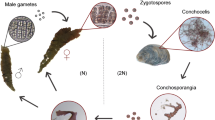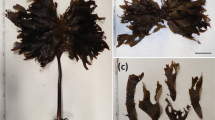Abstract
In anticipation of the application of a new sporeling-raising method using gametophyte clones to Laminaria commercial cultivation in China, techniques of mass culture and gametogenesis induction of L. japonica gametophyte clones were developed, as a mass of fertile gametophytes is a prerequisite for sporeling-raising with the new method. Gametophyte clones which were subjected to fed-batch culture exhibited a classical logistic growth curve. Growth rates decreased gradually after 2 months of culture, and were negatively correlated to cell density. UNOVA also showed that only cell density has a significant effect on the growth of gametophyte clones under the experimental conditions. Based on the dynamics models revealed, a culture strategy only directed at the control of cell density was adopted. By this strategy, a total of 36 kg wet weight from an initial weight of 0.75 kg was achieved after 3 months culture in 100 20-L bottles. The final average density reached 24 g L−1. For the subsequent gametogenesis induction, amplificatory male and female gametophyte clones were cut, mixed and cultured in bottles under the same conditions used in amplification except for a change of photoperiod from continuous irradiance to 10 h light: 14 h dark cycle. Egg discharge occurred 10 days after the mixed culture and increased gradually with the culture duration. Most gametophytes gave rise to sporophytes 20 days after induction. Large-scale culture of gametophyte clones and gametogenesis induction for commercial cultivation in 2003–2005 have been conducted successfully.







Similar content being viewed by others
References
Alessandra DM, Bernard R, Jean CD, Hugues N, Lise C (2000) Effect of a cationic cellulosic polymer on gametophytes of Laminaria digitata (Laminariaceae, Phaeophyta): improvement of dispersed ‘free-living’ cultures. J Appl Phycol 12:83–93
Bergelson J, Purrington CB, Wichmann G (1998) Promiscuity in transgenic plants. Nature 395:25
Cui JJ, Ou YL (1979) Preliminary experiment of preserving gametophyte clone under feeble illumination. J Shangdong Coll Oceanol 1:133–137
Fang TC, Dai JX (1980) The use of haploid phases in the genetic study of Laminaria japonica. Acta Gen Sinica 7:19–25
Fang TC, Ou YL, Cui JJ, Dai JX (1978) Success in culturing clones of the gametophytes of Laminaria japonica. Trans Science 2:115–116
Fang TC, Cui JJ, Ou YL, Dai JX, Wang ML, Liu QS, Yang QM (1983) Breeding of the new variety “Danhai No. 1” of Laminaria japonica using a female haploid clone of the kelp. J Shandong Coll Oceanol 13:63–70
Fang TC, Ou YL, Cui JJ (1985) Breeding of hybrid Laminaria “Danza No. 10” − an application of the Laminaria haploid cell clones. J Shangdong Coll Oceanol 15:64–72
Gao JT, Zhang YC, Wang HH, Qin S (2005) Suspension culture of gametophytes of transgenic kelp in a photobioreactor. Biotech Lett 27:1025–1028
Jiang NE, Zuo YM, Fang TC (1980) Growth effect of boron on Laminaria japonica female gametophytes. J Shangdong Coll Oceanol 10:70–73
Johanna F, Keith D, Stephen SB (2005) Growth dynamics of non-toxic Pseudo-nitzschia delicatissima and toxic P. seriata (Bacillariophyceae) under simulated spring and summer photoperiods. Harmful Algae 4:763–769
Laing I, Helm MM (1981) Factors affecting the semi-continuous production of Tetraselmis suecica (Kylin) Butch in 200 l vessels. Aquacult 22:137–148
Lee JA, Brinkhuis BH (1988) Effect of temperature and light on gametogenesis of Laminaria saccharina at its southern limit of distribution in the Western Atlantic Ocean. J Phycol 24:181–191
Li DP, Zhou ZG, Liu HH, Wu CY (1999) A new method of Laminaria japonica strain selection and sporeling raising by the use of gametophyte clones. Hydrobiologia 398/399:473–476
Lüning K (1980) Critical levels of light and temperature regulating the gametogenesis of three Laminaria species (Phaeophyceae). J Phycol 16:1–15
Lüning K, Dring MJ (1975) Reproduction, growth and photosynthesis of gametophytes of Laminaria saccharina grown in blue and red light. Mar Biol 29:195–200
Lüning K, Neushul M (1978) Light and temperature demands for growth and reproduction of Lamiarian gamtophytes in southern and central California. Mar Biol 45:297–309
Montomara T, Sakai Y (1984) Regulation of gametogenesis of Laminaria and Desmarestia (Phaeophyta) by iron and boron. Jpn J Phycol 32:209–215
Ou YL, Cui JJ, Fang TC (1979) Reaction to continuous illumination of female gametophyte of Laminaria japonica. J Shangdong Coll Oceanol 1:128–131
Qi H, Rorrer GL (1995) Photolithotrophic cultivation of Laminaria saccharina gametophyte cells in a stirred-tank bioreactor. Biotechnol Bioeng 45:251–260
Stein JR (1973) Handbook of phycological methods and growth measurements. Cambridge Univ Press, Cambridge
Trotta P (1981) A simple and inexpensive system for continuous monoxenic mass culture of marine microalgae. Aquacult 22:383–387
Tseng CK (2001) Algal biotechnology industries and research activities in China. J Appl Phycol 13:375–380
Tseng CK, Sun KY, Wu CY (1955) On the cultivation of Haitai (Laminaria japonica Aresch.) by summering young sporophytes at low temperature. Acta Bot Sinica 4:255–264
Wang SJ (1994) Seaweed biotechnology. Shanghai Scientific & Technical, Shanghai, China
Westermeier R, Patiño D, Piel MI, Maier I, Müller D (2006) A new approach to kelp mariculture in Chile: production of free-floating sporophyte seedlings from gametophyte cultures of Lessonia trabeculata and Macrocystis pyrifera. Aquacult Res 37:164–171
Wu CY, Li DP, Liu HH, Peng G, Liu JX (2004) Mass culture of Undaria gametophyte clones and their use in sporeling culture. Hydrobiologia 512:153–156
Yarish C (1990) Growth and reproductive responses of Laminaria longicruris (Laminariales, Phaeophyta) to nutrient enrichment. Hydrobiologia 204/205:505–511
Yuan YJ, Ge ZQ (2004) Plant cell engineering. Chemical Industry Press, Beijing, China
Zhang QS, Tang XX, Zhang PY, Qu SC, Li XJ (2005) Study on seedling collection technology in the production of kelp gametophyte clone. High Technol Lett 15:89–92
Zhang QS, Tang XX, Cong YZ, Qu SC, Luo SJ, Yang GP (2006) Breeding of an elite Laminaria variety 90-1 through inter-specific gametophyte crossing. J Appl Phycol DOI 10.1007/s10811-006-9137-4
Zhi C, Rorrer GL (1996) Photolithotrophic cultivation of Laminaria saccharina gamtophyte cells in a bubble-column bioreactor. Enz Microbial Technol 18:291–299
Zhuang Y, Dai JX (1999) Effects of four kinds of growth hormone on the growth and development of female gametophytes of Laminiaria japonica. Journal of Ocean University of Qingdao 29:260–264
Acknowledgements
This work was financially supported by National High-Tech R & D Program (863 Program) of China (No. 2001AA621090) and the Developmental Program of Science and Technology of Shandong Province of China (No.031070137).
Author information
Authors and Affiliations
Corresponding author
Rights and permissions
About this article
Cite this article
Zhang, Q.S., Qu, S.C., Cong, Y.Z. et al. High throughput culture and gametogenesis induction of Laminaria japonica gametophyte clones. J Appl Phycol 20, 205–211 (2008). https://doi.org/10.1007/s10811-007-9220-5
Received:
Revised:
Accepted:
Published:
Issue Date:
DOI: https://doi.org/10.1007/s10811-007-9220-5




